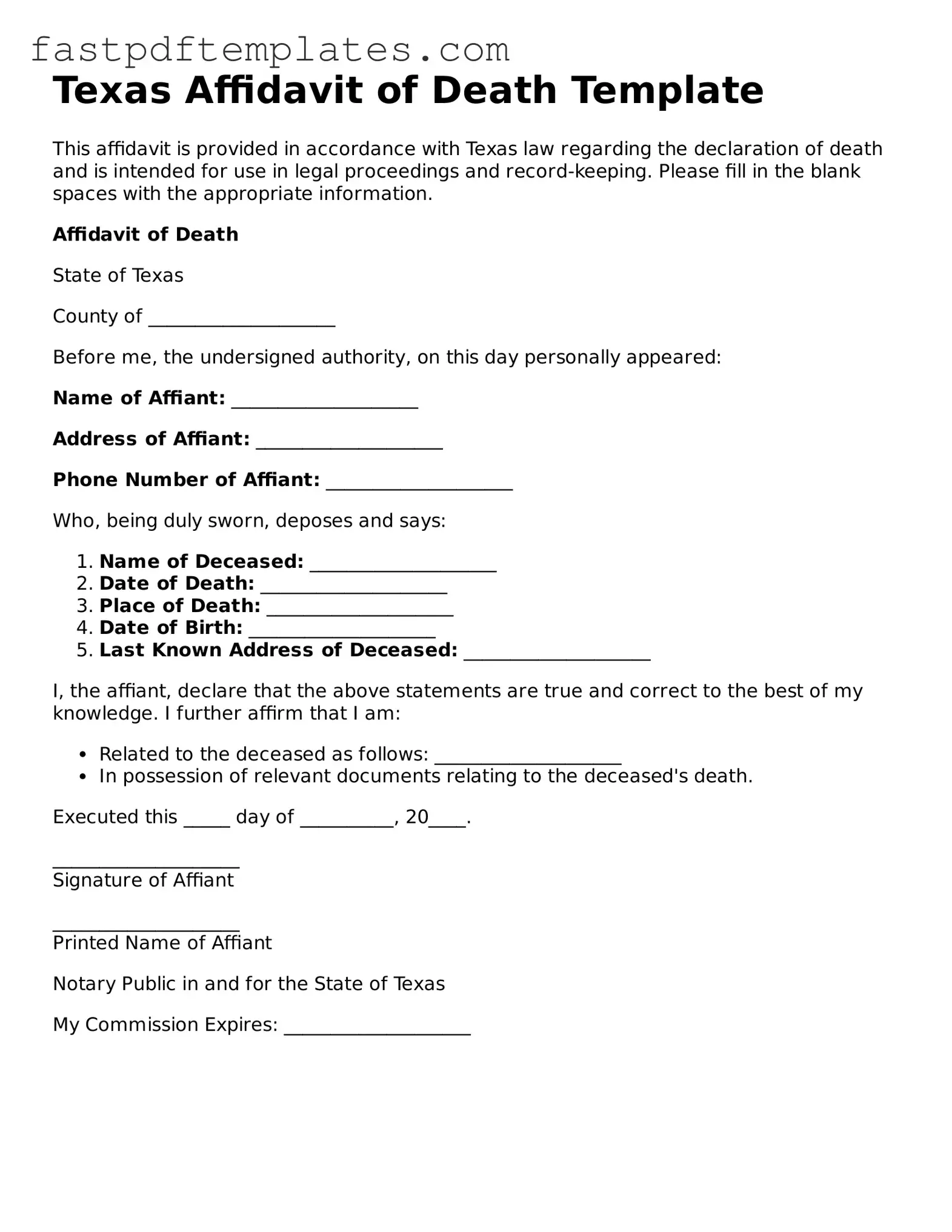The Texas Affidavit of Death form is similar to the Affidavit of Heirship. This document is used to establish the heirs of a deceased person when there is no will. It provides a sworn statement from individuals who are familiar with the family history, detailing the relationship of the heirs to the deceased. Both forms serve to clarify the legal status of an individual’s estate after death, but the Affidavit of Heirship focuses on identifying heirs rather than simply confirming death.
Another document akin to the Texas Affidavit of Death is the Death Certificate. A Death Certificate is an official record issued by a government authority that confirms an individual's death. It includes vital information such as the deceased’s name, date of birth, and date of death. While the Affidavit of Death serves as a sworn statement regarding the death, the Death Certificate is an official document that may be required for various legal processes, including settling an estate.
The Will is also similar in purpose to the Texas Affidavit of Death. A Will is a legal document that outlines how a person wishes their assets to be distributed after their death. While the Affidavit of Death confirms that an individual has passed away, the Will provides instructions for managing their estate. Both documents are critical in the estate planning process, although they serve different functions in the aftermath of death.
The Living Trust is another document that shares similarities with the Texas Affidavit of Death. A Living Trust allows individuals to manage their assets during their lifetime and specify how those assets should be distributed upon death. While the Affidavit of Death confirms the passing of an individual, the Living Trust serves as a tool to facilitate the transfer of assets without the need for probate, potentially simplifying the estate settlement process.
The Affidavit of Support is comparable to the Texas Affidavit of Death in that both are sworn statements used in legal contexts. An Affidavit of Support is often used in immigration processes to demonstrate that a sponsor can financially support an immigrant. While the Affidavit of Death addresses the status of a deceased individual, the Affidavit of Support confirms the financial capability of a living person, highlighting the importance of sworn statements in legal matters.
The Certificate of Death Registration is another document that aligns with the Texas Affidavit of Death. This certificate is issued by the state to officially record a death. While the Affidavit of Death is a sworn statement confirming death, the Certificate of Death Registration serves as an official record that may be required for various legal and administrative purposes. Both documents are essential in establishing the fact of death for legal proceedings.
The Probate Petition is also similar to the Texas Affidavit of Death. This document is filed with the court to initiate the probate process after someone has died. The Probate Petition often requires information about the deceased, similar to what is provided in the Affidavit of Death. Both documents play crucial roles in the administration of an estate, though the Probate Petition initiates legal proceedings, whereas the Affidavit of Death confirms the death itself.
The Power of Attorney can be compared to the Texas Affidavit of Death in terms of its legal implications. A Power of Attorney allows an individual to designate someone else to make decisions on their behalf. If the person with Power of Attorney passes away, the Affidavit of Death becomes necessary to formally recognize that the individual has died. While both documents involve authority and legal status, they address different aspects of a person's life and estate.
The Certificate of Marriage is another document that shares a connection with the Texas Affidavit of Death. This certificate serves as official proof of a marriage, which can be relevant when determining the heirs of a deceased individual. In cases where the deceased was married, the Certificate of Marriage may be required alongside the Affidavit of Death to establish the surviving spouse's rights to the estate. Both documents are essential in clarifying relationships after death.
Lastly, the Affidavit of Identity can be likened to the Texas Affidavit of Death. This document is used to verify an individual's identity, often in legal or financial contexts. While the Affidavit of Identity is focused on confirming who a person is, the Affidavit of Death confirms that a person has passed away. Both forms require sworn statements and play significant roles in legal documentation, emphasizing the importance of identity in various processes.
